What Is The Difference Between Genotype And Phenotype?
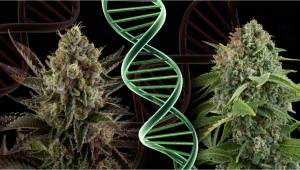
- 1. Indica, sativa, ruderalis, and hybrids
- 2. What is genotype and phenotype?
- 3. Phenohunting
- 3. a. Cloning
- 4. Best ways to show phenotypic traits
- 4. a. Temperatures
- 4. b. Stress
- 5. Identifying different phenotypes
- 6. In conclusion
Phenotype and genotype are not exclusive to cannabis but have been commonly used in the cannabis market for a while now, even though you can find these terms in a dictionary it will take a bit more to really understand what they mean when referring to cannabis plants. When talking about cannabis plants, genotype refers to the genetic code that carries the range of possibilities while phenotype is the expression of the genotype when exposed to a certain environment.
If you didn’t understand it completely and want to know more about it and how it affects cannabis seeds, here’s all you need to know about phenotype genotype, and cannabis.
1. Indica, Sativa, Ruderalis, and Hybrids
Before learning more about these terms in the cannabis world is essential you know a bit more about the beginning of cannabis strains; As you may know, cannabis dates back at least 3000 years so it’s extremely difficult to know exactly where it originated. Back then, there were landraces that evolved naturally for thousands of years and there was a clear distinction between Indica, Sativa, and Ruderalis which were shaped by environmental conditions.
So because these two species were growing and evolving in different conditions, Indicas were usually shorter with wider leaves and took less to grow, Sativas were taller with thinner leaves and took longer to grow, and Ruderalis’ grew around 50cm, were CBD-rich and didn’t depend on a light cycle to trigger flowering. The really interesting part of Indica and Sativa is that it really doesn't mean one will make you more uplifted or tired. Indica and Sativa really only give you an idea of which region the plant was originally from and has nothing to do with what to expect with the effect. A lot of the market in recent years has completely watered down what Indica and Sativa really mean.
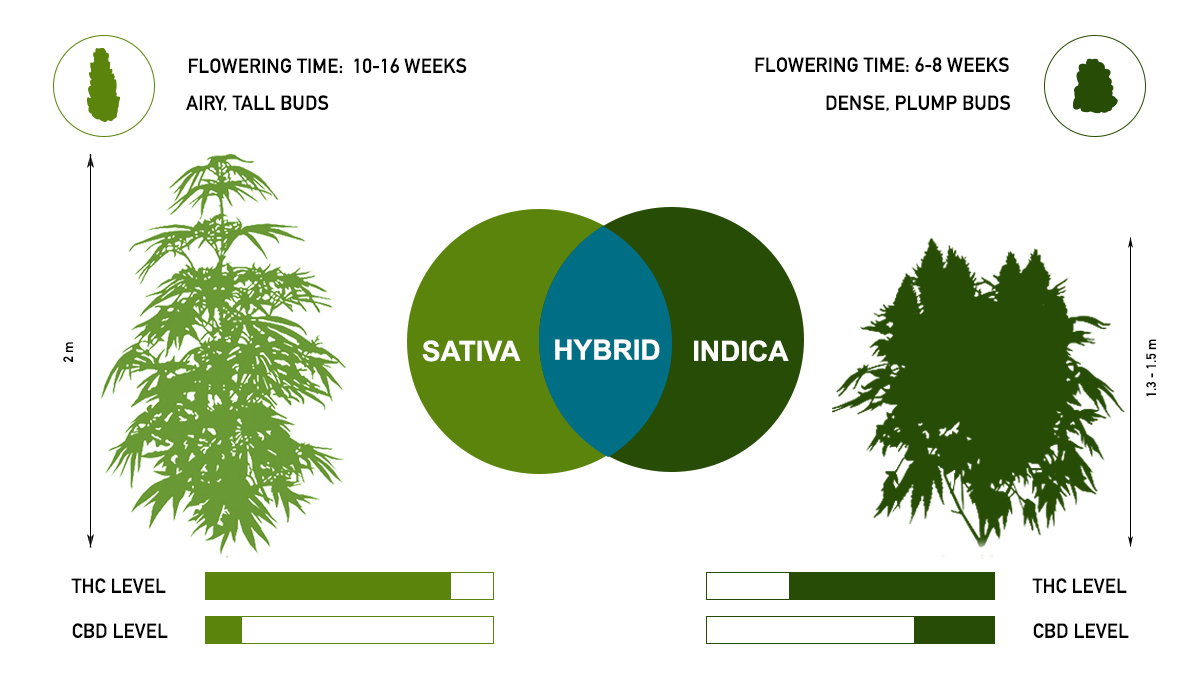
Fast forward to the late 1980s, breeding and indoor growing became more popular and hybrids were created (which are a mix of Indica and Sativa genetics), and because growers cultivated with different temperatures, humidity levels, light fixtures, and nutrients, growers soon realized that all of the external factors, even minor factors such as the angle of the lights could affect plants, expressing different characteristics even if they came from the same mother and father plant. Once breeding became more popular growers also realized that they can genetically manipulate their plant for their own environment without decreasing the quality or yield of the plant.
2. What Is Genotype And Phenotype?
All cannabis plants contain a genetic code just like any other living organism, this genetic code is known as genotype and refers to the potential of the plant, containing the characteristics that a certain cultivar can express when growing. Now, the phenotype are the visible traits that a specific growing environment (either indoor or outdoor) brings out during a cannabis plant’s life cycle, these characteristics include:
| Aroma | Length of the life cycle |
|---|---|
| Flavor | Resistance to pests and fungi |
| Effects | Structure |
| Yields | Mutation, deformities, and hermaphroditism |
| Colors | Resistance to harsh weather |
The easiest way for us to truly understand what this means is to relate to something that we all know and understand, humans. Genotype is the genetics you were given from your mother and father from birth and there is nothing you can do to genetically alter what you are made of. Your mixture of dominant and recessive genes will determine which of the traits from your parents you express. They are inherent within you and coded into specific cells of the body through messenger RNA—a single strand that copies codes from DNA in the nucleus and uses it to program ribosomes. These structures then use the code to piece together amino acids into long chains of proteins.
Phenotypes are the characteristics you acquire over time based on the environment, stressors, and lifestyle you choose to live. Let's say you have an identical twin brother or sister but you grow up separately in completely different houses. One sibling eats fast food every single day and is never physically active while the other sibling eats incredibly healthy and works out three times a week. This will create a huge difference in the appearance of the siblings, within a few years identical twins can go from looking the same to one being overweight and the other one being fit strictly based on environment and not genetics.
Ultimately, a phenotype is the expression of an organism's genetics based on the environment within which it lives. An example of this in cannabis includes colors. Some cannabis varieties end up looking much more purple than others. This is because their genetics code for higher levels of purple pigments known as anthocyanins. These molecules reflect purple light, whereas the pigment chlorophyll reflects green light. However, when plants have such high levels of anthocyanins, the amount of reflected light makes them appear purple, not green. While this appearance has its roots in genetics, it doesn't always show up. However, environmental factors, such as cooler night temperatures during the flowering phase of the growing cycle, prompt anthocyanins to develop. To put it in a simple way, you can see it as:
Genotype + Environment = Phenotype
3. Phenohunting
Phenohunting is the act of hunting or finding the best phenotype, now, the best phenotype will depend on what you are looking for and your objective, either producing seeds or growing the best for your own consumption. When deciding to grow a new strain, you will have to buy a pack of seeds and it’s possible for each one to be a different phenotype of the same strain, so you will have to grow and label them to identify them easily, following their progress, and taking notes until you can separate males from females.
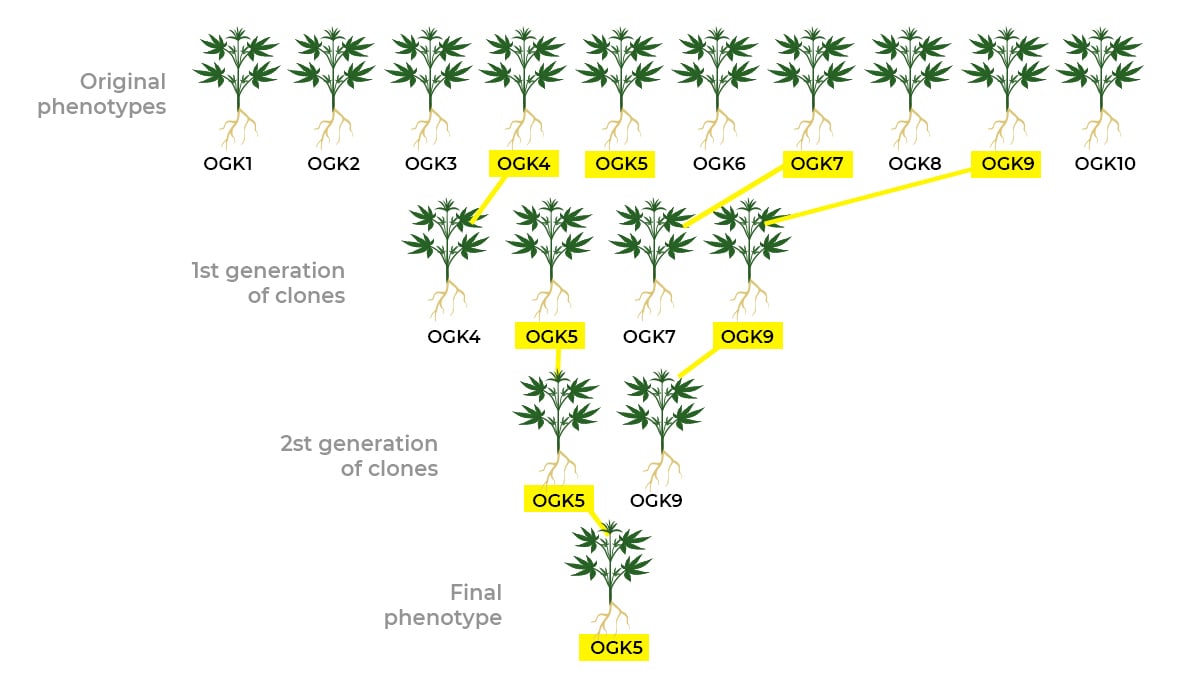
After growing all of the seeds you will end up with slightly different plants and you will pick your favorite one, either by aroma, flavor, effect, or any of the traits mentioned before. Now, phenohunting isn’t necessarily hard, as said above, it depends on what you are aiming for, if you’re a breeder and are planning to sell the seeds you will have to select one or two phenotypes from hundreds or thousands of plants but if you’re a home grower this process can be reduced and done with 10-20 plants.
It doesn’t matter if you are growing 10 or 1000, the process is basically the same and you will have to continue until you find the phenotype that you were looking for. Phenohunting is ideal for commercial producers of cannabis so they can achieve the same yield at the end of each harvest without worrying about flower having different effects and cannabinoids.
Cloning
Cloning is usually the process that comes after finding that phenotype you were looking for, it consists of copying the genes of a specific plant and it’s basically the only way of obtaining an identical plant, now, cloning can be done by tissue culture or by simply getting a cutting from a specific plant.
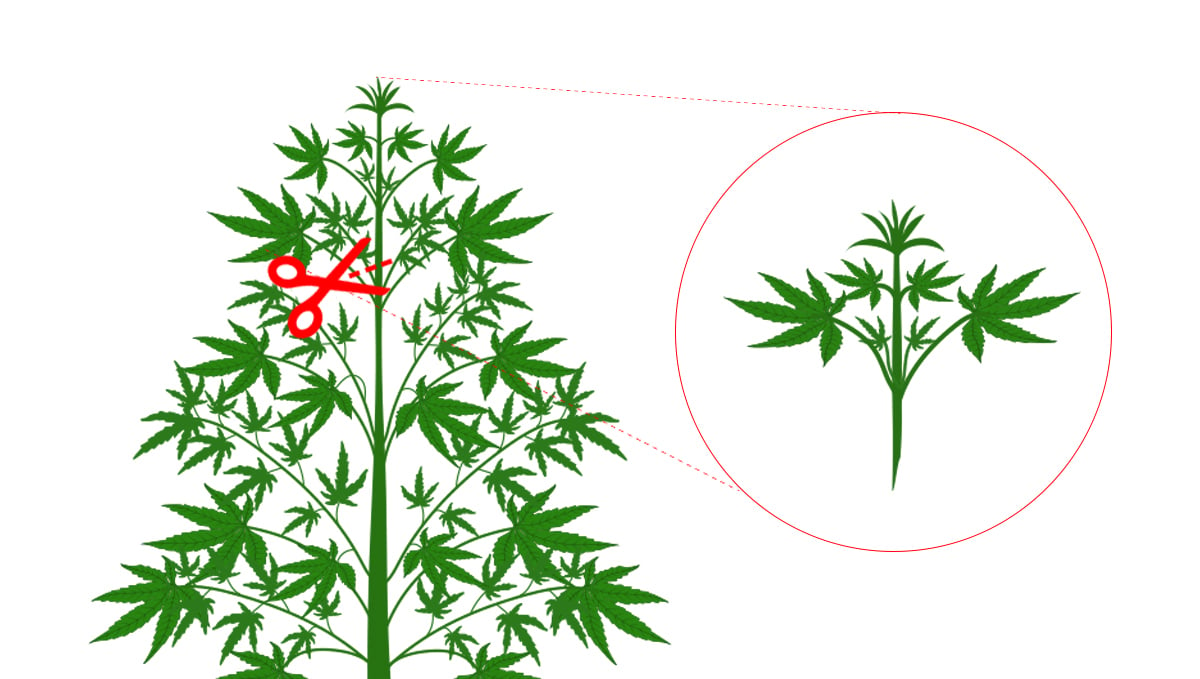
This method is used by growers who have already selected a good phenotype and want to continue growing an exact copy of that specific phenotype or by commercial growers who want to continue growing that special flower that the customers love. Have in mind that cloning will result in the same exact plant if grown in the same conditions, as said above, the expressed phenotype is a result of the environment so if you select a phenotype, clone it and end up cultivating it in different conditions, it’s most likely you end up with a slightly different plant.
Always try to remember once you found your prized pheno during flower you must re-veg before trying to take a clone. The plant creates completely different hormones during flower and will result in the cloning process to take extremely long or not be successful whatsoever. Also never take a clone from another clone, only use mother plants that come from seed to have the most vigor and effectiveness. The factors that can affect a phenotype expression are:
| Light spectrum | Humidity |
|---|---|
| Light source (sunlight, LED or Bulbs) | Medium |
| Temperature | Nutrients |
| PH Levels | Oxygen and CO2 |
4. Best Ways to Show Phenotypic Traits
From our experience the most effective way to show phenotypic traits is with temperature fluctuations and stress during the flowering cycle.
Temperatures
Manipulating temperatures during flower drastically will change the physical appearance of the bud and can give them extremely high bag appeal while also having beautiful fall colors with hues of purple, pink and yellow. When growing outdoors these colors might be much easier to achieve because the temperatures will automatically drop during the fall. To get the opportunity to get these beautiful colors indoors you must drop nighttime temperatures during the last three to four weeks of flower. The cold makes it so the chlorophyll becomes less prominent in the plant allowing you to really see the full potential of your genetics.
Stress
Certain stress for a cannabis plant is another way for the plant to express its own phenotypic traits. Now we are not talking about pouring ice water on your plants or breaking any branches, it can be as simple as letting the plant dry out more than usual. While it is always beneficial to let your plants go through a wet and dry cycle, during flower you will increase terpene and trichome production allowing the plant to dry out more. Just extending the watering day a single day can improve the trichome content of the plant. The trichomes are designed to protect the plant from the harsh rays of the sun and act as a shield or preservation method for the plants. Allowing the plant to dry out will make the plant think it is going to be dying sooner and the plant is trying to protect itself from the harmful sun rays since it has no water. Stresses like this will have the plant create secondary metabolites which greatly increases terpene and cannabinoid production.
5. Identifying Different Phenotypes
To help you visualize how these different phenotypes are expressed, here are a couple of photos of our Gorilla Glue Auto by different growers.
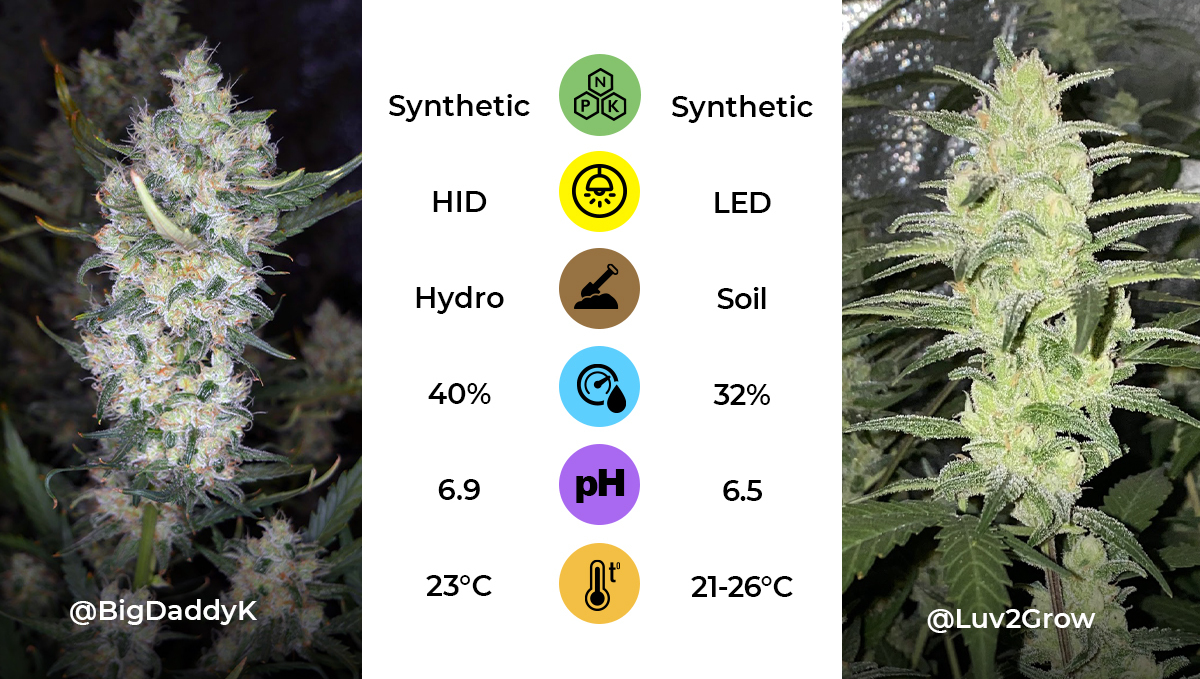
As you can see in the images, both plants look similar but there are minor differences that were most likely influenced by the different medium and light fixture used, so despite growing the same strain in similar conditions, both came out looking different.
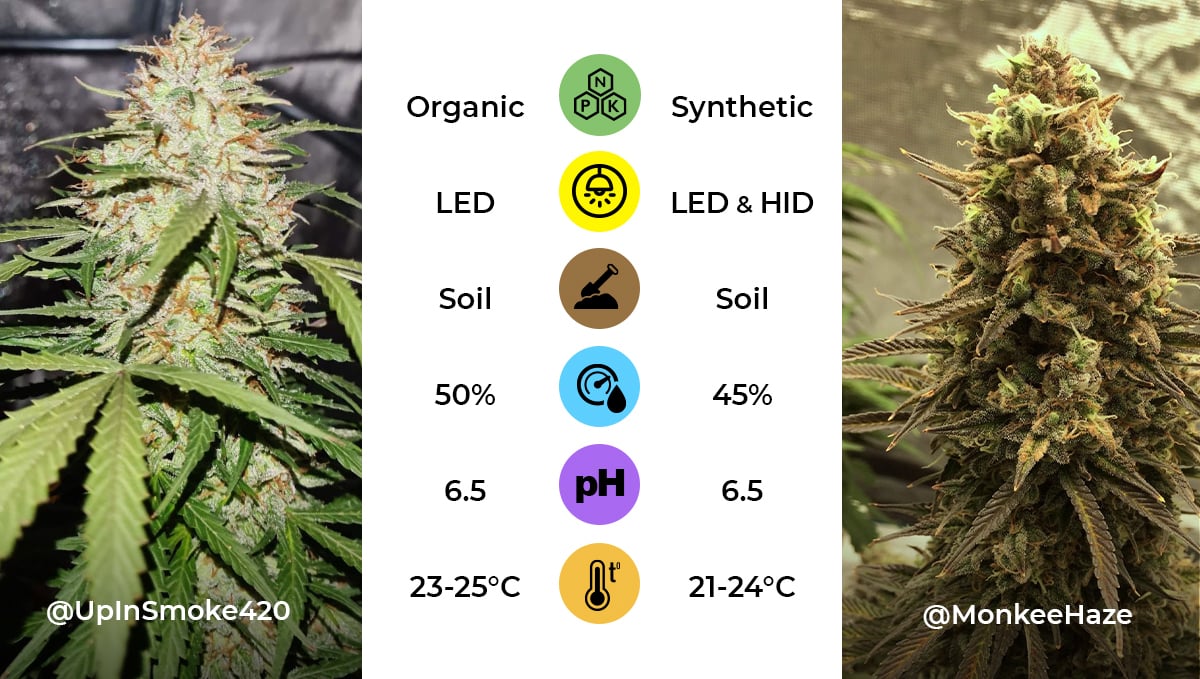
In this other example, it looks like the buds have a similar structure but one was with organic nutrients and an LED light fixture while the other one grew under both LED and HID with synthetic nutrients, you can clearly see the differences between them, one developed a darker color with less foliage while the other one stayed bright-green and with more leaves.
Have in mind this doesn’t mean that one grower or plant is better than the other, these are just the different traits that a strain can express when grown in different environments, so the plants will have similar characteristics but they may differ a bit. In all honesty, once the nutrients become bioavailable to the plant whether it's synthetic or organic the plant cannot tell the difference between the nutrients. The only difference and advantage organic growers have is that oftentimes when plants are grown organically the plant creates secondary metabolites which have a great effect on tastes, smells, and potency.
6. In Conclusion
Being on the subject of pheno and genotypes you should always get the best genetics for your grow. Always set yourself up for success because you will be spending the next three to four months growing these plants and you don't want to waste your time. Research different strains and get a real idea of what you're looking for, we know there will be a perfect strain for you.
If you have experience with phenohunting or any additional information to help fellow growers please leave a comment in the comment section below!
EXTERNAL REFERENCES
- Gene Networks Underlying Cannabinoid and Terpenoid Accumulation in Cannabis. Plant Physiology. - Zager, Jordan & Lange, Iris & Srividya, Narayanan & Smith, Anthony & Lange, Bernd. (2019).
- High genes: Genetic underpinnings of cannabis use phenotypes. - Thorpe, Hayley & Talhat, M. & Khokhar, Jibran. (2020).








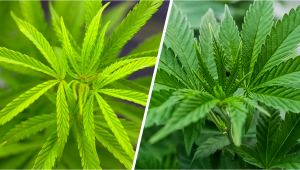
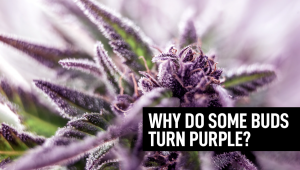


Comments